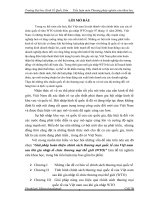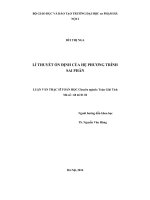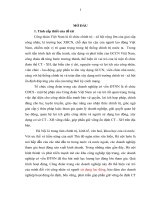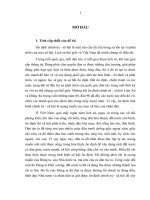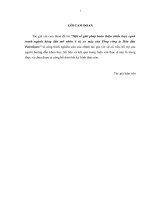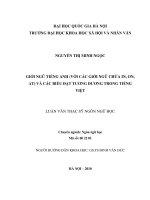(Luận văn thạc sĩ) effects of porosity on free vibration and nonlinear dynamic response of multi layered functionally graded materials subjected to blast loads
Bạn đang xem bản rút gọn của tài liệu. Xem và tải ngay bản đầy đủ của tài liệu tại đây (1.31 MB, 57 trang )
VIETNAM NATIONAL UNIVERSITY, HANOI
VIETNAM JAPAN UNIVERSITY
DO THI THU HA
EFFECTS OF POROSITY ON FREE
VIBRATION AND NONLINEAR DYNAMIC
RESPONSE OF MULTI-LAYERED
FUNCTIONALLY GRADED MATERIALS
SUBJECTED TO BLAST LOAD
MASTER’S THESIS
Ha Noi, 2020
VIETNAM NATIONAL UNIVERSITY, HANOI
VIETNAM JAPAN UNIVERSITY
DO THI THU HA
EFFECTS OF POROSITY ON FREE
VIBRATION AND NONLINEAR DYNAMIC
RESPONSE OF MULTI-LAYERED
FUNCTIONALLY GRADED MATERIALS
SUBJECTED TO BLAST LOAD
MAJOR: INFRASTRUCTURE ENGINEERING
CODE: 8900201.04QTD
RESEARCH SUPERVISOR:
Dr. TRAN QUOC QUAN
Ha Noi, 2020
ACKNOWLEDGEMENT
First of all, I would like to express my sincere appreciation to my supervisor ,
Dr. Tran Quoc Quan who has guided and created favorable conditions and regularly
encouraged me to complete this thesis. Thank you for all your thorough and
supportive instructions, your courtesy and your enthusiasm. Without your dedicated
guidance, I absolutely have not conducted this research well.
Secondly, I would like to express my great thankfulness to Master’s
Infrastructure Engineering Program for their wonderful supports, especially Prof.Sci.
Nguyen Dinh Duc, Prof. Kato, Prof. Nagayama, Dr. Phan Le Binh, Dr. Nguyen Tien
Dung and Mr. Bui Hoang Tan. Their encouragement and assistance has facilitated
me a lot during 2 years studying in the VietNam – Japan University. I also want to
give my special thanks to all lecturers and staffs at The University of Tokyo for their
warmly welcome and supports me in the internship time at Japan.
Thirdly, I would like to thank all the members at the Advanced Materials and
Structural Laboratory, University of Technology- VNU, especially for Mr. Vu Dinh
Quang, Mr. Vu Minh Anh, Mr. Pham Dinh Nguyen spending their precious time to
point out for me which theories and methodology should I use and give me advices
to improve my thesis.
Finally, there are my family and my friends, who always stay by my side,
motivate and encourage me from the beginning until the end of my studying.
I
TABLE OF CONTENTS
ACKNOWLEDGEMENT................................................................................................... I
LIST OF TABLES ............................................................................................................ III
LIST OF FIGURES........................................................................................................... IV
NOMENCLATURES AND ABBREVIATIONS .......................................................... V
ABSTRACT ....................................................................................................................... VI
CHAPTER 1: INTRODUCTION.................................................................................. 1
1.1
Overview ................................................................................................................ 1
1.1.1 Composite material – Functionally Graded Materials .............................. 1
1.1.2 FGM classification ........................................................................................ 2
1.1.3 Blast load ........................................................................................................ 5
1.2
Research objectives .............................................................................................. 6
1.3
The layout of the thesis ........................................................................................ 6
CHAPTER 2: LITERATURE REVIEW...................................................................... 8
2.1
Structures ............................................................................................................... 8
2.2
Porosity .................................................................................................................. 9
2.3
Blast load .............................................................................................................10
CHAPTER 3: METHODOLOGY...............................................................................12
3.1
Configurations of analyzed models ..................................................................12
3.2
Methodology........................................................................................................17
3.3
Theoretical formulation......................................................................................18
3.4
Solution procedure ..............................................................................................24
3.5
Vibration analysis ...............................................................................................25
3.5.1 Dynamic response problem ........................................................................25
3.5.2 Natural frequency ........................................................................................27
CHAPTER 4: NUMERICAL RESULTS AND DISCUSSION..............................28
4.1
Validation of the present results .......................................................................28
4.2
Natural frequency ...............................................................................................30
4.3
Dynamic response...............................................................................................33
CHAPTER 5: CONCLUSIONS ..................................................................................40
APPENDIX ........................................................................................................................41
II
LIST OF TABLES
Table 1.1. Properties of component materials of FGM material [3] ........................... 2
Table 4.1. Comparison the natural frequencies s 1 of homogenous plates with
a / b 1, a / h 20, k1 0, k2 0 and T 0. ..............................................................28
Table 4.2. Comparison of natural fundamental frequency parameters of simply
square FGM plates with other theories ( h / b 0.1 ). .................................................29
Table 4.3. The effects of porosity ratio on natural frequency of FGM sandwich plates.
..............................................................................................................................................31
Table 4.4. Influences of temperature increment, elastic foundations and the volume
fraction index on natural frequencies of the FGM sandwich plate with porosity I. ..32
III
LIST OF FIGURES
Fig. 1.1. The distribution types of FGM sandwich material. ......................................... 5
Fig. 3.1. FGM sandwich plate resting on elastic foundation. ......................................12
Fig. 3.2. FGM-ceramic- FGM model. ............................................................................13
Fig. 3.3. Porosity – I: evenly distributed, Porosity – II: unevenly distributed. .........14
Fig. 3.4. Blast pressure function ......................................................................................17
Fig. 4.1. Influences of power law index N on the nonlinear dynamic response of the
FGM sandwich plates with porosity I. ............................................................................33
Fig. 4.2. Influences of power law index N on nonlinear dynamic response of the
FGM sandwich plates with porosity II. ..........................................................................33
Fig. 4.3. Influences of porous ratio on nonlinear dynamic response of the FGM
sandwich plates with porosity I. ......................................................................................34
Fig. 4.4. Influences of type of porosity on nonlinear dynamic response ...................35
Fig. 4.5. Influences of a / b ratio on nonlinear dynamic response of the FGM
sandwich plates with porosity I. ......................................................................................36
Fig. 4.6. Influences of a / h ratio on nonlinear dynamic response of the FGM
sandwich plates with porosity I. ......................................................................................37
Fig. 4.7. Influences of Pasternak foundation on nonlinear dynamic response of the
FGM sandwich plates with porosity I. ............................................................................37
Fig. 4.8. Influences of Winkler foundation on nonlinear dynamic response of the
FGM sandwich plates with porosity I .............................................................................38
Fig. 4.9. Effect of parameter characterizing the duration of the blast pulse Ts on
nonlinear response of the FGM sandwich plate with porosity I under blast load .....39
IV
NOMENCLATURES AND ABBREVIATIONS
FGM
h
hc
Functionally Graded Material
The length of plate
The width of plate
The thickness of plate
The thickness of the core layer
hf
The thickness of FGM face-sheet
k1
The Winker foundation
k2
The Pasternak foundation
GPa
m, n
GigaPascal = 109 Pascal
Numbers of half waves in x, y direction
a
b
V
ABSTRACT
The effects of porosity ratio on free vibration and nonlinear dynamic response
of FGM sandwich plates with two FGM face-sheets and a homogeneous core as
ceramic resting on elastic foundations subjected to blast load are investigated in this
thesis by implementing the third-order shear deformation theory. Two types of
porosity are proposed, namely evenly distributed porosity and unevenly distributed
porosity. Assumption that the material properties of multi-layered FGM plate to be
changed in the thickness direction accord with a simple-power law distribution with
regard to the volume proportion of the components. This study obtains numerical
results by using the Galerkin method and fourth-order Runge-Kutta method
illustrating the significant effects of porous fractions, geometrical parameters, the
elastic foundation, blast loads on the nonlinear dynamic response of FGM sandwich
plates.
Key words: Porosity, Functionally graded sandwich plate, Blast loading, The
third-order shear deformation theory.
VI
CHAPTER 1:
1.1
INTRODUCTION
Overview
1.1.1 Composite material – Functionally Graded Materials
Composite material is a material composed of two or more different types of
component materials in order to achieve superior properties such as light weight, high
stiffness and strength, ability of heat resistance and chemical corrosion resistance,
good soundproofing, thus it plays a crucial role in advanced industries in the world
that are extensively applied across wide range of fields such as: aviation, aerospace,
mechanics, construction, automotive... [1] [2]. However, this material has a defect as
a sudden change of material properties at the junction between the layers is likely to
generate large contact stresses at this surface. One of the solutions to overcome this
disadvantage of layered composite material is to use Functionally Graded Material
(FGM) which is a material made up of two main component materials as ceramic and
metal, in which the volume ratio of each component varies smoothly and
continuously from one side to the other according to the thickness of the structure so
the functional materials avoid the common disadvantages in composite types such as
the detachment between layers material, fibers breakage and high stress in the surface,
which can cause material destruction and reduce the efficiency of the structure,
especially in heat-resistant structures.. Due to the high modulus of elasticity E , the
thermal conduction coefficient K and the very low coefficient of thermal expansion
, the ceramic composition makes the material highly variable with high hardness
and very good heat resistance. While the metal components make the modified
materials more flexible, more durable and overcome the cracks that may occur due to
the brittleness of ceramic materials when subjected to high temperature (Table 1.1).
1
Table 1.1. Properties of component materials of FGM material [3]
Properties
Material
2
E (N /m )
(o C 1 )
K (W / mK )
(kg / m3 )
70.0 109
0.30
23.0 106
204
2707
Ti 6 Al 4V
105.7 109
0.298
6.9 106
18.1
4429
Ceramic: Zirconia
( ZrO2 )
151109
0.30
10 106
2.09
3000
320 109
0.26
7.2 106
10.4
3750
Aluminum
( Al )
Aluminum oxide
1.1.2 FGM classification
Depending on the power law of the volume ratio of component materials, we
can classify different types of FGM. Each of these FGM materials is characterized by
different mechanical and physical properties by a function that determines the
material properties (effective properties), and the value of the function varies with
thickness. Mathematical functions of material properties used to classify materials
[4]. Specifically, there are three main types of FGM.
A power-law distribution P-FGM: is a type of material having a volume
fractions of ceramic and metal components which is assumed to vary according to
thickness of structure and conforming to the power-law function [5, 6]:
2z h
Vm ( z )
,Vc ( z ) 1 Vm ( z ),
2h
N
(1.1)
where
Vm ,Vc
: the volume fractions of metal and ceramic, respectively
N
: the volume distribution (0 N )
2
The effective properties Peff of the P- FGMs are established using the modified
mixed rules as follows [7]:
(1.2)
Peff ( z ) Prc Vc ( z ) Prm Vm ( z ),
in which Pr denotes a specific property of the material such as elastic modulus E ,
thermal expansion coefficient or density , thermal conduction K .
Sigmoid-law distribution S-FGM: is a type of material having a volume
fractions of ceramic and metal components which is assumed to vary according to
thickness of structure and conforming to the Sigmoid-law function as:
2 z h N
, h/2 z 0
h
Vm ( z )
, Vc ( z ) 1 Vm ( z ).
N
2 z h
h , 0 z h / 2
(1.3)
The effective properties Peff of the S- FGMs are established using the modified
mixed rules as follows:
Preff z PrcVc z PrmVm z
2 z h N
, h/2 z 0
h
Prc Prm Prc
.
N
2 z h
h , 0 z h / 2
(1.4)
An exponential-law distribution E-FGM: is a type of material having a volume
fractions of ceramic and metal components which is assumed to vary according to
thickness of structure and conforming to the exponential-law function as:
E z Ae
B z h / 2
(1.5)
,
where
3
1 E
A Et , B ln b
h Et
,
(1.6)
Et is the elastic modulus of structure on the top z h / 2 .
Eb is the elastic modulus of structure on the bottom z h / 2 .
FGM sandwich material: The multi-layered sandwich structure is a
particularly important type of structure in the aerospace industry as well as in a
number of other industries such as ships, automobiles, construction .... Sandwich
structure consists of 3 main layers: core layer and two face-sheets. The core layer is
made of lightweight material, low hardness between two face-sheets made of very
high hardness material. The great advantage of sandwich structure is that it increases
the stiffness and bending resistance of the structure while ensuring a small volume,
because the core layer is made of light material that can be made with a large
thickness that will have an effect to transfer the two face-sheets away from the neutral
axis.
To avoid the phenomenon of flaking between the layers as well as the
phenomenon of stress caused as with conventional multi-layer structures, it was
thought that FGM sandwich material with ceramic or metal core layer and two facesheets made of FGM material.
4
a. Sandwich FGM- Metal-FGM
b. Sandwich FGM- Metal-FGM
Fig.1.1. The distribution types of FGM sandwich material .
The effective properties of this materials vary according to the extended
Sigmoid distribution law as follows:
kt
2z h
Pri Pri
, h / 2 z h / 2 ht ,
2ht
Preff Pr j ,
h / 2 ht z h / 2 hb ,
kb
2 z h
, h / 2 hb z h / 2,
Pri Pr ji
2
h
b
(1.7)
with the case of type 1-1a: i c, j m, and the case of type 1-1b: i m, j c.
1.1.3 Blast load
Blast load: In recent years, the safety of important buildings and infrastructure
around the globe has become more fragile by extreme dynamic loads due to the
increase in terrorist activities, explosions... The damage from such events cannot be
determined, not just economically because many of these ones are symbolic and
important heritage, significant architectures and the spirit of the times. Nowadays,
considerable efforts in architecture and structural engineering in recent years are often
5
focused towards optimal design and economic efficiency in construction. It is
essential to guarantee the safe and secure protection of important infrastructure for
the present and future.
Explosion loads usually act in a very short time (usually in milliseconds) but
transmit very high pressure pulses ( 101 103 kPa). As a result, damage to structural
systems can take many forms, such as damage to the outer surface and structural
frame of a building; collapse of walls and bearing columns; blow debris of concrete,
glass windows and furniture; and damaging safety systems. Most existing buildings
are not designed to withstand such extreme dynamic loads, so a comprehensive
understanding of the explosion phenomena and the dynamic response of structures is
required to be essential for the scientific basis improving the design and material
improvement in a feasible manner, in order to improve explosion resistance and
ensure the safety of structures. Therefore, the investigation of the effects of explosive
loading on structures should be focused.
1.2
Research objectives
The research objective of this thesis is to investigate the effects of porosity on
vibration and nonlinear dynamic response of multi-layered FGM subjected to blast
load.
Studies the effects of porosity to FGM sandwich plates and comparison with different
cases: FGM plates without porosity, porous -I FGM plates and porous-II FGM plates.
Investigations on nonlinear dynamic analysis on the structure in FGM plates on
elastic foundation subjected to blast load. In numerical results, the effects of the
material properties, geometrical parameters, blast load… on the nonlinear dynamic
response will be analyzed.
1.3
The layout of the thesis
The thesis includes an introduction, five chapters, conclusions, references and
appendices. The main contents of the chapters involve:
6
Chapter 1: Introduction
The thesis presents an overview of FGM materials. Porosities are also mentioned
in this chapter.
Chapter 2: Literature review
Chapter 2 presents some studies which have been reported to this thesis’s field. In
those publications, I also pointed out their main outstanding results obtained from
their research as well as those research’s limitation.
Chapter 3: Methodology
Chapter 3 introduces the analytical method by using high-order shear deformation
to approach and solve problems…
Chapter 4: Numerical results and discussion
The numerical results are presented in this chapter for a FGM sandwich plate on
elastic foundation in terms of natural frequencies, effects of geometrical parameters,
materials properties on nonlinear dynamic response.
Chapter 5: Conclusions
Chapter 5 summarize the main results obtained from this thesis.
7
CHAPTER 2:
2.1
LITERATURE REVIEW
Structures
Because of their remarkable properties, in recent years, sandwich FGM
structure has been attracted a lot of attention of scientists. Among those, Zhaobo Chen
et.al [8] presented the free vibration of the functionally graded material sandwich
doubly-curved shallow shells under simply supported conditions according to a new
shear deformation theory with stretching effects. The wave propagation of FGM
sandwich plates with porosities putting on viscoelastic foundation was studied by
Chen Liang and Yan Qing Wang [9] based on a quasi-3D trigonometric shear
deformation theory. Singh and his co-authors [10] used a semi-analytical approach to
analyze thermo-mechanical of porous sandwich S-FGM plate for different boundary
conditions using Galerkin Vlasov's method. Furthermore, the nonlinear vibration of
imperfect sandwich plates with FGM face sheets also investigated by Kitipornchaii
et al. [11] basing on a semi-analytical approach. Hoang Van Tung [12] are analyzed
nonlinear bending and post buckling behavior of FGM sandwich plates under
thermomechanical loading by using the first order shear deformation theory. The
effect of time constant, temperature, mid radius to thickness ratio and time on
transient thermo-elastic behavior of sandwich plate with the core as FGM are taken
into consideration by Alibeigloo [13]. In his analysis, the sandwich plate’s time
dependent response is built from generalized coupled thermo-elasticity when
applying the Lord-Shulman expression. Moreover, Xia and Shen [14] introduced an
analytical using higher-order shear deformation and a general von Kármán-type
function to obtain small- and large-amplitude vibration of compressive and thermal
post-buckling sandwich plates with FGM face sheets under uniform and non-uniform
temperature fields. Behzad Mohammadzadeh [15] combined higher-order shear
deformation with Hamilton’s principle to analyze nonlinear dynamic responses of
sandwich plates with FGM faces on elastic foundation subjected to blast loads.
Basing on a new four-variable shear deformation plate theory, Mohammed Sobhy
8
[16] evaluated the hydrothermal vibration and buckling of various types of FGM
sandwich plates resting on elastic foundations exposed moisture condition, rising
temperature, Winkler–Pasternak foundation coefficients and power- law distribution
index. Chien et al. [17] used isogeometric approach to investigate static, free vibration
and buckling analysis of FGM isotropic and sandwich plates. Tao Fu et al. [18]
adopted the space harmonic approach and virtual work principle to describe
analytically sound loss when transmitting through two types of
porous FGM
sandwich structures.
2.2
Porosity
The effects of porosities generated during actual manufacturing process to the
vibration characteristics of FGM structures have been studied by several authors.
However, the number of researches in terms of the mechanical behaviors of porous
materials is still limited. The most recent investigations on structures with porosity
are listed in the following.
Ashraf M.Zenkour [19] used a quasi-3D shear deformation theory to
investigate the bending responses of porous functionally graded single-layered and
multi-layered thick rectangular plates. By taking Galerkin Vlasov's method into
account in thermo-mechanical analysis of sandwich S-FGM plate with three different
types of
porosity for diverse boundary conditions, Singha and co-author [20]
obtained the approach for bending and stress under the thermal environment. They
deduced that the deflection and stress escalate significantly for even porosity
distribution (P-1) to bring into comparison with uneven symmetric (P-2) or uneven
non-symmetric (P-3) porosity distribution; and the effects of temperature on
transverse shear stresses of the multi-layered plates. Mojahedin [21] employed higher
order shear deformation theory to investigate the buckling of functionally graded
porous circular plates. Polat et al. [22] utilized an atmospheric plasma spray system
to obtain functionally gradient coatings from five layers which were prepared on Ni
substrates from Y2O3 stabilized ZrO2 (YSZ) and NiCoCrAlY powders. In their
9
research, they found that an escalation in porosity ratio of layers lead to the decrease
of residual stresses. Chen et al. [23] employed Chebyshev-Ritz method to analyze
buckling and bending loads of a novel functionally graded porous plates. Wang et al.
[24] focused on effects of parameters on the vibrations of functionally graded material
rectangular plates with two types of porosity, namely, even and uneven distributed
porosity, and transferring in thermal environment. Based on a sinusoidal shear
deformation theory in combination with the Rayleigh–Ritz method, Yuewe Wang et
al. [25] depicted the effects of porosity, boundary conditions, and geometrical
parameters on free vibration of the functionally graded porous cylindrical shell. An
isogeometric finite element model and the nonlocal elasticity were introduced by
Phung-Van et al. [26] to investigate the transient responses of functionally graded
nanoplates with porosity. Small size effects, nonlocal parameters, and porosity
distributions, volume index, the characteristics of dynamic load have considerably
influenced on the plate nonlinear transient deflections. Cong et al. [27] acquired
closed-form expression in regard to critical bucking loads and post-buckling paths of
a porous functionally graded plates on elastic foundations subjected to the coupling
of mechanical and thermal loads by applying Reddy's higher-order shear deformation
plate theory in conjunction Galerkin method. Analytical solutions and numerical
results revealed that porosity I (evenly distribution) behaves better than porosity II
(unevenly distribution) according to the static buckling investigations. Chien et al
[28] adopted the first-order shear deformation theory taking the out-of-plane shear
deformation into account to calculate the fundamental frequencies and nonlinear
dynamic responses of porous functionally graded sandwich shells with double
curvature under the influence of thermomechanical loads. This study proved that
porosities help the shell structures stiffen to some extent.
2.3
Blast load
In recent years, explosive loads and their impacts on the safety and efficiency
of building and structures have received considerable attention. Tuan et al. [29]
presented the results of an empirical investigation conducted in Woomera, Southern
10
Australia, in May 2004 on the explosion-resistance of concrete-panel created by
ultrahigh-strength concrete material. A finite-element method was used to analyze
concrete structures under blast and impact loading. In the study conducted by Tin and
co-authors [30] , they proposed using the explicit finite element software LS-DYNA
to induce stress wave propagation and the impacts on structural responses of precast
concrete segmental columns subjected to simulated blast loads. Balkan et al. [31]
examined the effects of sandwich stiffeners on the dynamic response of laminated
composite plates under the non-uniform blast loading. Moreover, the dynamic
behavior of stiffened plates exposed to confined blast loads are carried out by Zhao
et al. [32] through experimental and numerical studies. Geretto et al. [33] analyzed a
series of experiments of square monolithic steel plates to assess the effects of the
degrees of confinement of the deformation to blast loads. Asoylar et al. [34] studied
the transient stability analysis metal-fiber laminated composite plates under no-ideal
explosion load by experiment and finite element methods. In addition, Uybeyli and
colleagues [35] used SiC reinforced functionally gradient material via powder
metallurgy to investigate the impact of armor piercing projectile. Bodaghi et al. [36]
studied non-linear active control of dynamic response of functionally graded beams
with rectangular cross-section in thermal environments under blast loadings.
Based on meticulous investigations in the available literature, it can be
concluded that there are few free vibration and nonlinear dynamic behaviors of
porous functionally graded sandwich plates resting on elastic foundations regardless
of the high demand for understanding. In particular, literature review indicates lack
of investigations on effects of porosity on this structure exposed to blast loads. This
study has been implemented to meet the demand.
11
CHAPTER 3:
3.1
METHODOLOGY
Configurations of analyzed models
The geometry configuration of the rectangular FG sandwich plate with two FGM
face-sheets and the core as ceramic resting on elastic foundations under blast load are
as follows (Figs 3.1 and 3.2). The plate is referred to a Cartesian coordinate system
x, y, z , where xy is the mid-plane of the plate and z is the thickness coordinator,
h / 2 z h / 2 .
a, b : the length and width of the plate.
h, hc , h f : thickness of the total plate, the core and the face-sheets.
z
b
shear layer
y
a
h
x
Fig. 3.1. FGM sandwich plate resting on elastic foundation.
12
Fig. 3.2. FGM-ceramic- FGM model.
The sandwich plate is composed of three elastic layers, namely: “Layer 1”,
“Layer 2”, “Layer 3” corresponding with FGM face-sheet, the core and FGM facesheet. The FGM face-sheets are made from a mixture of metal and ceramic. The facesheets and the core satisfy power-law distribution and the constituent volume fraction
varying continuously along thickness direction. The assumption of the metal and
ceramic volume is written as:
(3.1)
Vc ( z ) Vm ( z ) 1
The ceramic volume of each layer are expressed as follows:
N
h 2z
Vc ( z ) h /2 z hc /2
,
2
h
f
Vc ( z ) | hc /2 z hc /2 1,
(3.2)
N
Vc ( z ) |h /2 z h /2
c
h 2z
.
2h
f
in which the volume ratio of the metal in the plate is denoted as Vm ( z ) . The volume
ratio of the ceramic is denoted as Vc ( z ) . The volume fraction index N defines the
distribution of component materials in the structure and N [0, ) .
13
In the case of N = 0, the face-sheet is made entirely of ceramic. In the case of
N , the face-sheet is made entirely of metal.
The reaction–deflection relation of Pasternak foundation is defined as follows:
(3.3)
qe k1w k2 2 w
2
2
with 2 2 , w is the deflection of the sandwich plate, k1 , k 2 are respectively
x
y
2
Winkler foundation modulus and the shear layer foundation stiffness of Pasternak
model.
The FG sandwich plate contains porosities in its structure, which can be
dispersed evenly or unevenly along the plate thickness. Two types of porosity are
considered, namely evenly distribution (Porosity I) and unevenly distribution
(Porosity II) as shown in Fig.3.3.
Fig. 3.3. Porosity – I: evenly distributed, Porosity – II: unevenly distributed.
The effective properties P( z, , T ) such as the elastic moduli E ( z, , T ) , the
mass density ( z, , T ) and the thermal expansion coefficient ( z, , T ) are defined
as [28]:
Porosity I:
Pface z 1 Pm T Pc T Pm T Vc ,
Pcore z 1 Pc T ,
14
(3.4)
Porosity II:
h2 z
Pface z 1
Pm T Pc T Pm T Vc ,
2h f
Pcore z 1 Pc T ,
(3.5)
where denotes the coefficient of porosity which is defined by calculating the ratio
the void volume and the total volume (0 1) .
The material properties of each face-sheet and the core with two types of pore
distribution such as elastic modulus E , thermal expansion coefficient and mass
density are determined for the details by the formula:
Porosity I:
(3.4a)
E( z)
Ec
( z ) 1
c
( z ) core
c
The FGM face-sheet
hf
2
z
hc
:
2
Em Ec Em
N
E( z)
h 2 z
( z )
1 m c m
2h
f
( z ) face1
m c m
The FGM face-sheet
(3.4b)
h
hc
z f :
2
2
Em Ec Em
N
E ( z)
h 2 z
( z )
1 m c m
,
2h
f
( z ) face 2
m c m
Porosity II:
15
(3.4c)
The core
hc
h
z c:
2
2
(3.5a)
E( z)
Ec
( z ) 1
c
( z ) core
c
The FGM face-sheet
hf
2
z
hc
:
2
Em Ec Em
N
E ( z)
h 2 z h 2 z
( z )
1
m c m
2
h
2h f
f
( z ) face1
m c m
The FGM face-sheet
(3.5b)
h
hc
z f :
2
2
Em Ec Em
N
E ( z)
h 2 z h 2 z
( z )
1
m c m
2h f 2h f
( z ) face 2
m c m
(3.5c)
where Ecm Ec Em , cm c m , cm c m , Kcm Kc K m , and the Poisson
ratio z is assumed to be constant ( z ) v .
The blast load q(t ) is a short–term load and is a rapid release of stored energy
from an explosion, a shock-wave disturbance or a supersonic projectile…. Part of
the energy is released as thermal radiation (flash); and part is coupled into the air as
air blast and into the soil (ground) as ground shock, both as radially expanding shock
waves. It can be considered as the models in [37] and shown in Fig. 3.4.
16
Fig. 3.4. Blast pressure function
where the "1.8" factor accounts for the effects of a hemispherical blast, Psmax is the
maximum (or peak) static over-pressure, b is the parameter controlling the rate of
wave amplitude decay and Ts is the parameter characterizing the duration of the blast
pulse.
3.2
Methodology
Natural frequencies and nonlinear dynamic responses of functionally graded
sandwich plates with porosities under the influence of blast loadings are studied in
this thesis. The investigated FGM sandwich plate consists of two face-sheets and a
core layer as FGM-ceramic-FGM which satisfy the continuity requirement of
material properties. The strain-displacement relations taking into account the Von
Karman nonlinear terms and the higher order shear deformation theory deduce
motion and geometric compatibility equations of the sandwich plate. After
introducing the Airy stress function, the number of primary variables diminishes from
five to three. This thesis utilizes the Bubnob-Galerkin procedure to solve the
governing equation of the dynamic system. The natural frequencies of the sandwich
plate are analytically determined directly by taking the smallest value as solving
eigenvalue problems. Applying the fourth-order Runge-Kutta method obtains
numerical results to illustrate the nonlinear dynamic behaviors of the porous multilayered FGM plates exposed to the effects of diverse geometry configurations, the
17


